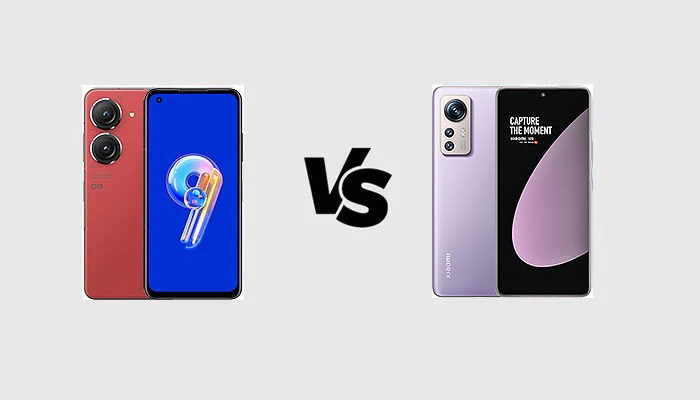A few days ago, Asus launched the most compact premium flagship of 2022: the Asus Zenfone 9. There is no more compact phone than this if we only consider devices with flagship-class hardware in the Android world. However, there are a few other compact flagships out there, even though they come with bigger dimensions. One of these is the Xiaomi 12S, and it is the latest one released if we exclude the new Asus product. We already compared the Zenfone to the Samsung Galaxy S22 which is currently the compact flagship from the leader of the smartphone market. Now, it is time for a comparison between the main specifications of the Asus Zenfone 9 and the Xiaomi 12S. Which one offers the highest value for money? We hope to answer this question through this comparison.

Asus Zenfone 9 vs Xiaomi 12S
| Asus Zenfone 9 | Xiaomi 12S | |
|---|---|---|
| DIMENSIONS AND WEIGHT | 146.5 x 68.1 x 9.1 mm, 169 g |
152.7 x 69.9 x 8.2 mm, 179 g |
| DISPLAY | 5.9 inches, 1080 x 2400 pixels (Full HD+), Super AMOLED | 6.28 inches, 1080 x 2400 pixels (Full HD+), AMOLED |
| PROCESSOR | Qualcomm Snapdragon 8+ Gen 1, octa-core 3.19 GHz | Qualcomm Snapdragon 8+ Gen 1, octa-core 3.19 GHz |
| MEMORY | 8 GB RAM, 128 GB – 8 GB RAM, 256 GB – 16 GB RAM, 256 GB | 8 GB RAM, 128 GB – 8 GB RAM, 256 GB – 12 GB RAM, 256 GB – 12 GB RAM, 512 GB |
| SOFTWARE | Android 12, Zen UI | Android 12, MIUI |
| CONNECTIVITY | Wi-Fi 802.11 a/b/g/n/ac/6e, Bluetooth 5.2, GPS | Wi-Fi 802.11 a/b/g/n/ac/6e, Bluetooth 5.2, GPS |
| CAMERA | Dual 50 + 12 MP, f/1.9 + f/2.2 12 MP f/2.5 front camera |
Triple 50 + 13 + 5 MP, f/1.9 + f/2.4 + f/2.4 32 MP f/2.5 front camera |
| BATTERY | 4300 mAh, fast charging 30W | 4500 mAh, Fast Charging 67W, Fast wireless charging 50W |
| ADDITIONAL FEATURES | 5G, dual SIM, reverse charging, IP68 waterproof | 5G, dual SIM slot, reverse wireless charging |
Design
As already mentioned in the intro, the Asus Zenfone 9 is a more compact phone than the Xiaomi 12S. However, the Xiaomi is built with more premium materials, including glass for the rear side and aluminum for the frame. The Zenfone has an aluminum frame too, but its rear side is made of plastic. Further, the 12S is thinner and lighter than its rival, even though it sports a bigger battery. On the other hand, it is the only device in this duo to feature the IP68 certification making it dustproof and waterproof. Personally, I prefer the Xiaomi due to its premium materials and because it has a higher screen to body ratio with narrower bezels around the display, but it is essentially a matter of tastes.
Display
If you are looking for the easiest display to use with one hand or to keep in a pocket, then you should choose the Asus Zenfone 9 because of its 5.9-inch diagonal and its compact dimensions. But if you are looking for better image quality, then the Xiaomi 12S is a better phone. Its AMOLED display is able to show up to 68 billion colors with a diagonal of 6.28 inches, a Full HD+ resolution of 1080 x 2400 pixels, a 120 Hz refresh rate, the HDR10+ certification, and Dolby Vision support. The Asus Zenfone has an inferior display but it is still a great AMOLED panel with a Full HD+ resolution, a 120 Hz refresh rate, and the HDR10+ certification. Note that the Xiaomi has an in-display fingerprint reader, while the fingerprint scanner of the Zenfone is side-mounted, on the power key, despite the phone having an AMOLED display. Both the handsets feature good stereo speakers.
Specs & Software
There are no big differences between the hardware departments, but the Asus Zenfone 9 is more convincing because it sports up to 16 GB of RAM, while the Xiaomi 12S features just 12 GB of RAM. On the other hand, Xiaomi is able to provide a higher amount of internal storage, with up to 512 GB. Both the phones are powered by the best Qualcomm chipset to date. We are talking about the Snapdragon 8 Plus Gen 1 built with a 4 nm production process and with an octa-core architecture. It is composed of a Cortex X2 CPU running at a max frequency of 3.19 GHz, three Cortex A710 CPUs running at 2.75 GHz, and four Cortex A510 CPUs running at 1.8 GHz, as well as an Adreno 730 GPU. These devices run Android 12 out of the box customized by Zen UI and MIUI, respectively.
Camera
These two phones are very close even when it comes to camera performance. With the Asus Zenfone 9, you get a dual camera setup composed of a 50 MP main camera supporting gimbal OIS and a 12 MP ultrawide lens, as well as a 10 MP front camera which is able to record 4K videos a 30 fps. The Xiaomi 12S gets a 50 MP main camera with OIS, a 13 MP ultrawide lens, and a 5 MP macro sensor co-engineered with Leica, as well as a 32 MP front camera which is able to record 1080p videos at 60 fps. On paper, the Xiaomi looks slightly better, but we still have to see how the algorithm will behave.
Battery
The Xiaomi 12S is equipped with a bigger battery with a capacity of 4500 mAh and it will most likely provide a longer battery life in most of the scenarios. Further, it even comes with better charging technologies: it features 67W fast charging and 50W wireless charging. The Asus Zenfone 9 has a 4300 mAh battery with 30W fast charging and no wireless charging.
Price
The starting price of the Asus Zenfone 9 in the global market is €729/$750, while you need at least €570/$580 to purchase the Xiaomi 12S in China. Note that the 12S is not available in the global market, at least for now. Now that you know all the differences, which one would you pick?
Asus Zenfone 9 vs Xiaomi 12S: PRO and CONS
Asus Zenfone 9
PRO
- Better front camera
- More compact
- Up to 16 GB of RAM
- IP68 waterproof
- Wider availability
CONS
- Slower charging
Xiaomi 12S
PRO
- Wider display
- Faster charging
- Bigger battery
- Wireless charging
- More premium materials
CONS
- Dimensions
RELATED
- OnePlus 10T vs OPPO Reno8 Pro: Specs Comparison
- Realme GT 2 Master Explorer vs OPPO Reno8 Pro: Specs Comparison
- OPPO Find X5 vs OPPO Reno8 Pro: Specs Comparison
- Asus ROG Phone 6 vs Black Shark 5 vs REDMAGIC 7: Specs Comparison
Check the latest videos from our YouTube channel and subscribe:







